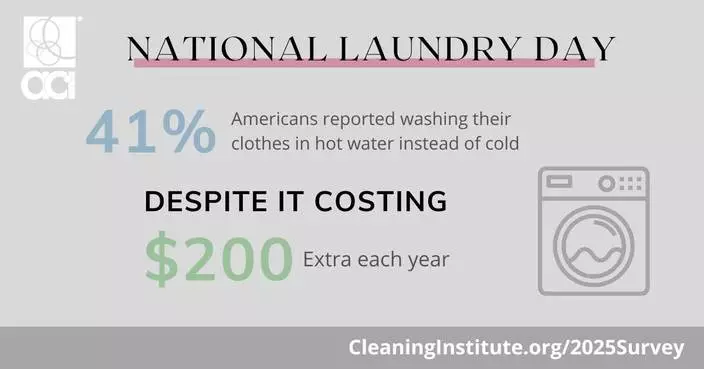ASILOMAR, Calif.--(BUSINESS WIRE)--Apr 7, 2025--
At the Joint ENC-ISMAR Conference 2025, Bruker Corporation, the leading provider of Nuclear Magnetic Resonance (NMR) spectroscopy solutions, announced the launch of an innovative Fourier 80 multinuclear benchtop FT-NMR spectrometer, known as the ‘Multi-Talent’ configuration. This novel Fourier 80 ‘Multi-Talent’ system represents a major advancement in permanent magnet-based FT-NMR technology, as its unique, next-generation capabilities meet the evolving needs of academic researchers and industry scientists with dramatically enhanced versatility in benchtop FT-NMR multinuclear analysis.
This press release features multimedia. View the full release here: https://www.businesswire.com/news/home/20250407545969/en/
The Fourier 80 ‘Multi-Talent’ system measures or decouples 1 H, and in addition can select one of 15 different X-nuclei to be either observed in X{ 1 H} experiments, or selected X-nuclei can be decoupled for proton observation in 1 H{X} experiments. This enables many types of X-nucleus observations, various 2D experiments, and importantly also the exquisitely sensitive inverse 1 H observation methods for 13 C, 19 F or 15 N experiments.
Similarly, the Fourier 80 ‘Multi-Talent’ can observe 19 F{ 1 H} with proton decoupling for the simplification of 19 F spectra, a capability of high interest to pharmaceutical customers studying fluorinated drug candidates. For battery research, the Fourier 80 ‘Multi-Talent’ enables nuclei observations from Li-brine mining, like 7 Li, 23 Na, and 11 B for the formulation of battery electrolytes. Novel electrochemical systems can be explored to advance next generation battery technologies. These unprecedented benchtop capabilities are selectable via software, eliminating the need for NMR probe tuning and matching.
The ‘Multi-Talent’ uses standard 5 mm NMR samples, includes gradient spectroscopy, with options for adjustable sample temperature (AT), or sample changer automation. The user-friendly Fourier 80 interface ensures that novice and experienced users can navigate through measurements effortlessly, streamlining complex tasks and enhancing productivity.
Dr. Agnes Haber, the Fourier 80 Product Manager at Bruker BioSpin, stated: "The Fourier 80 ‘Multi-Talent’ represents a game-changing advancement in benchtop FT-NMR, with next-generation multinuclear capabilities addressing the demand for a versatile system for 1 H-NMR, plus an unprecedented choice of fifteen X-nuclei, with ease, and even under automation. We have already successfully installed a dozen Fourier 80 multinuclear systems in customer labs, and we anticipate that this novel system may become the new de facto standard in benchtop multinuclear NMR spectroscopy."
About Bruker Corporation – Leader of the Post-Genomic Era (Nasdaq: BRKR)
Bruker is enabling scientists and engineers to make breakthrough post-genomic discoveries and develop new applications that improve the quality of human life. Bruker’s high performance scientific instruments and high value analytical and diagnostic solutions enable scientists to explore life and materials at molecular, cellular, and microscopic levels. In close cooperation with our customers, Bruker is enabling innovation, improved productivity, and customer success in post-genomic life science molecular and cell biology research, in applied and biopharma applications, in microscopy and nanoanalysis, as well as in industrial and cleantech research, and next-gen semiconductor metrology in support of AI. Bruker offers differentiated, high-value life science and diagnostics systems and solutions in preclinical imaging, clinical phenomics research, proteomics and multiomics, spatial and single-cell biology, functional structural and condensate biology, as well as in clinical microbiology and molecular diagnostics. For more information, please visit www.bruker.com.


Novel multinuclear benchtop Fourier 80 ‘Multi-Talent’ with optional sample changer automation
U.S. egg prices increased again last month to reach a new record-high of $6.23 per dozen despite President Donald Trump’s predictions, a drop in wholesale prices and no egg farms having bird flu outbreaks.
The increase reported Thursday in the Consumer Price Index means consumers and businesses that rely on eggs might not get much immediate relief. Demand for eggs is typically elevated until after Easter, which falls on April 20.
Industry experts were expecting the index to reflect a drop in retail egg prices because wholesale egg prices dropped significantly in March. University of Arkansas agricultural economist Jada Thompson said the wholesale prices did not start dropping until mid-March, so there may not have been enough time for the average price for the month to decline even though prices started to fall at the end of the month. And grocery stores may not have immediately passed on the lower prices.
Bird flu outbreaks were cited as the major cause of price spikes in January and February after more than 30 million egg-laying chickens were killed to prevent the spread of the disease. Only 2.1 million birds were slaughtered in March and none of them were on egg farms
The farms that had fall outbreaks have been working to resume egg production after sanitizing their barns and raising new flocks, but chickens must be about six months old before they start laying eggs. Thompson said those farms did not come back online as quickly as anticipated. In the latest U.S. Department of Agriculture numbers, there were only about 285 million hens laying eggs nationwide as of March 1, down from 293 million the previous month. Before the outbreak, the flock typically numbered more than 315 million.
Trump tried to take credit for the lower wholesale egg prices the USDA reported in recent weeks. But experts say the president’s plan to fight bird flu by focusing on strengthening egg farmers’ defenses against the virus is likely to be more of a long-term help.
“I think there are lots of people who are looking to see the egg prices coming down because they wanted to call it a win. And I think it’s a loss for everybody. I think we all want to see egg prices come down,” Thompson said.
Trump and Vice President JD Vance both trumpeted the overall decline in inflation last month before most of Trump's tariffs took effect, but they did not directly address egg prices.
Earlier this week, Trump said the annual White House egg roll would use real eggs again this year despite the high prices. Egg farmers typically donate more than 30,000 eggs for the event.
But some consumers are already looking to plastic eggs to color for Easter to avoid the high prices.
U.S. egg prices did began falling in mid-March, according to Datasembly, a market research company that tracks prices at thousands of stores. Datasembly said eggs averaged $5.98 per dozen the week beginning March 16 and dropped to $5.51 the week beginning March 30.
But prices vary widely around the country, depending on the location of recent bird flu outbreaks and some state laws requiring eggs to be cage-free. At a Safeway in downtown San Francisco on Thursday, cage-free eggs were $9.99 per dozen. At a Safeway in Denver, the same cage-free eggs were $6.69 per dozen. And at a Safeway in Washington D.C., which doesn’t require eggs to be cage-free, a dozen eggs were $5.29. In Omaha, Nebraska, Walmart is selling eggs for $4.97 per dozen.
Egg prices are still expected to decline further later this spring, but the latest numbers could also increase scrutiny of Cal-Maine Foods, which provides 20% of the nation’s eggs, and other large egg producers.
Earlier this week, Cal-Maine acknowledged it is being investigated by the antitrust division of the U.S. Department of Justice, which is looking into egg price increases. Cal-Maine said it is cooperating with the investigation.
In its most recent quarter, which ended March 1, Cal-Maine said its net income more than tripled to $508.5 million compared to the same period a year ago. The company said its revenue nearly doubled to $1.42 billion, largely because of higher egg prices.
Since the current bird flu outbreak began, more than 168 million birds have been slaughtered, most of them egg-laying chickens. Any time a bird gets sick, the entire flock is killed to help keep bird flu from spreading. That can have an effect on the egg supply because massive egg farms may have millions of birds.
The disease is difficult to control because it is spread easily through the droppings of wild birds that carry the avian flu virus. Bird flu has also inflected other animals, including dairy cattle.
Egg prices hit $5.90 in February one month after setting a record at $4.95 per dozen, according to the U.S. Bureau of Labor Statistics. But shoppers encountered prices much higher than that in some places; in California, the price per dozen topped $12 in some stores.
Earlier in the outbreak, egg prices spiked to hit $4.82 in January 2023 before gradually falling as low as $2.04 per dozen in August 2023. Generally, prices have since increased steadily.
Associated Press writer Dee-Ann Durbin contributed to this report.
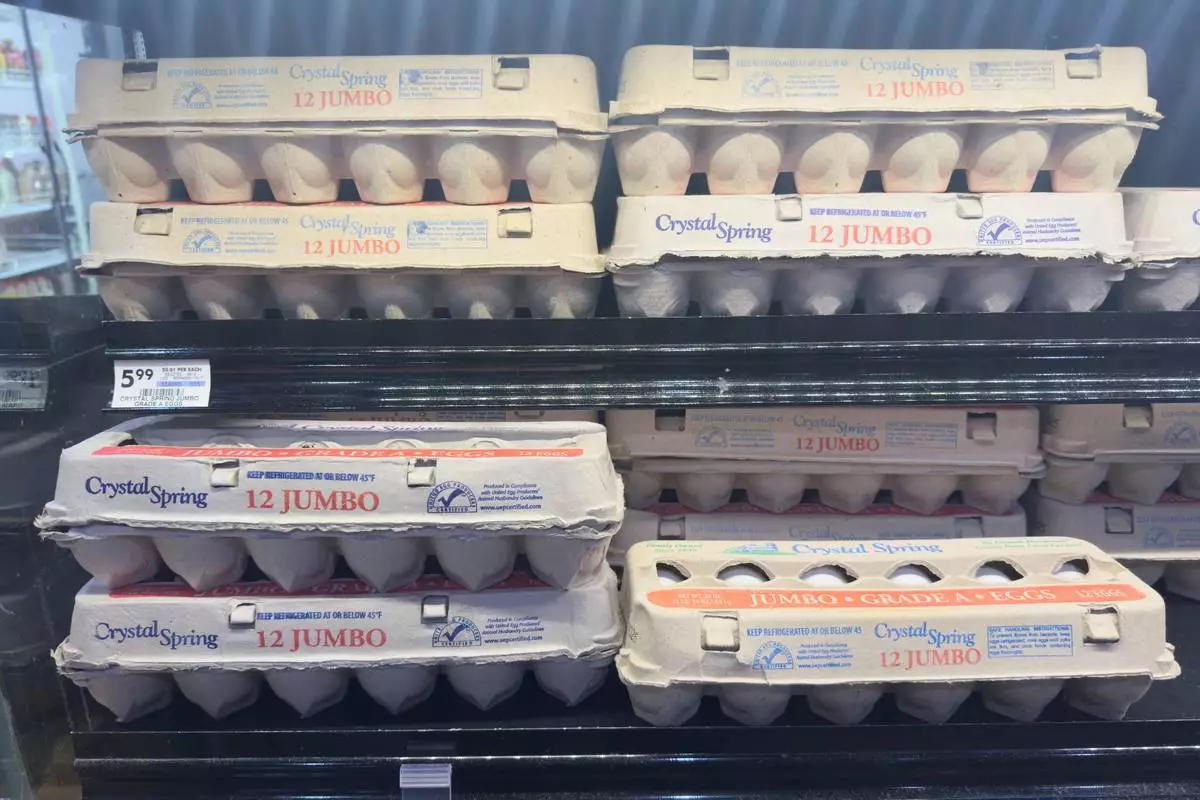
Eggs are displayed in a grocery store in Carmel, Ind., Wednesday, April 9, 2025. (AP Photo/Michael Conroy)

Eggs are displayed in a grocery store in Carmel, Ind., Wednesday, April 9, 2025. (AP Photo/Michael Conroy)
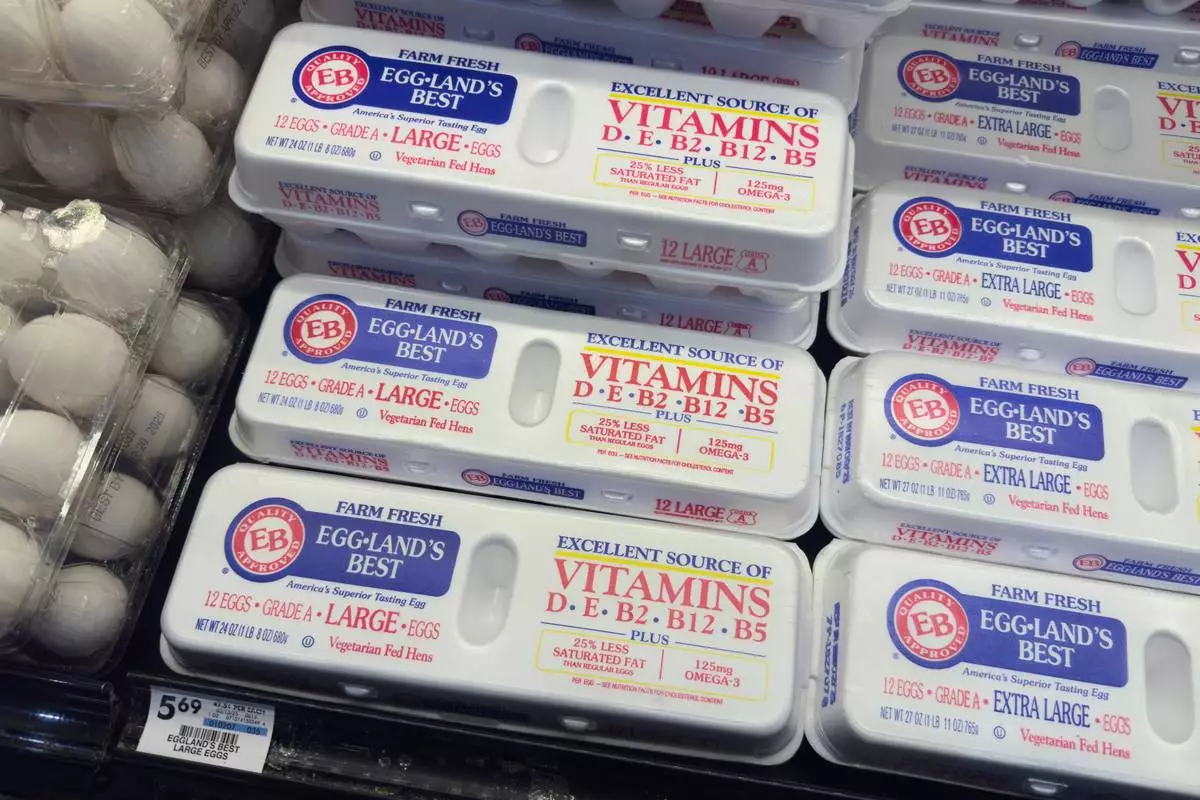
Eggs are displayed in a grocery store in Carmel, Ind., Wednesday, April 9, 2025. (AP Photo/Michael Conroy)

Eggs are displayed in a grocery store in Carmel, Ind., Wednesday, April 9, 2025. (AP Photo/Michael Conroy)
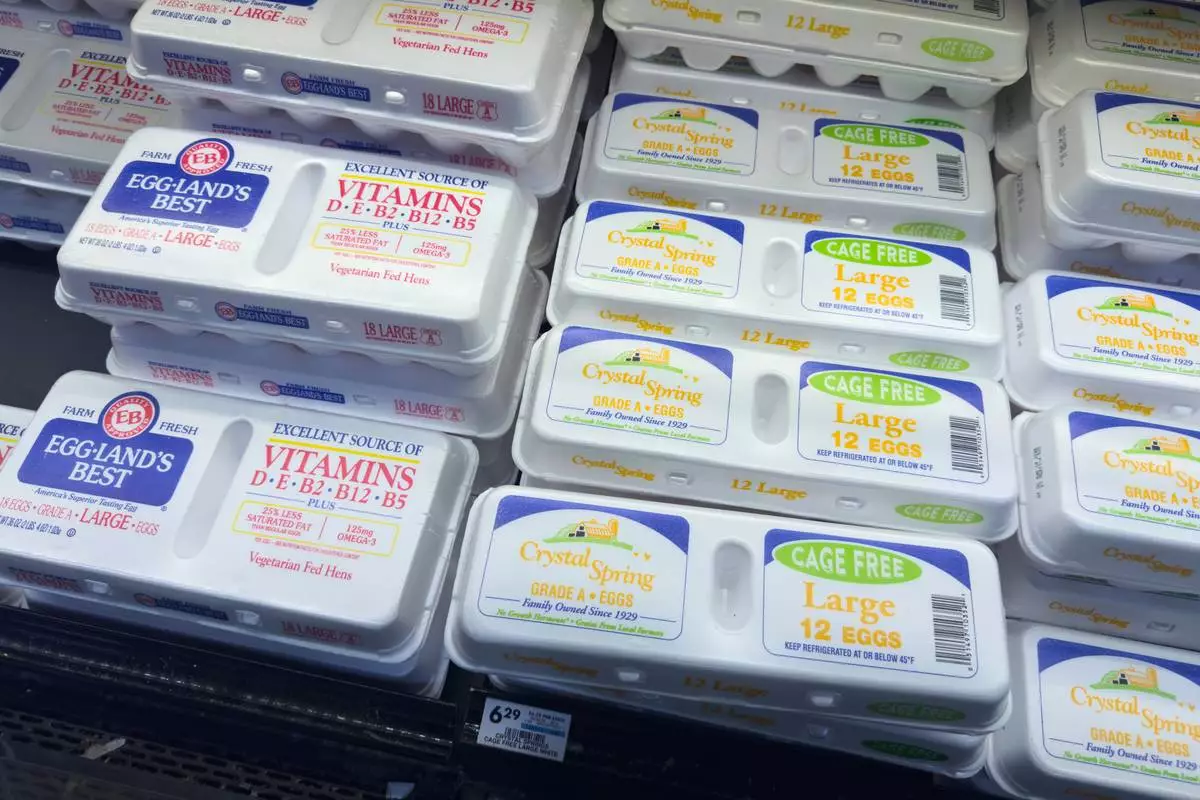
Eggs are displayed in a grocery store in Carmel, Ind., Wednesday, April 9, 2025. (AP Photo/Michael Conroy)

FILE - Cartons of eggs sit on a shelf in a Walmart store, March 10, 2025, in Englewood, Colo. (AP Photo/David Zalubowski, File)
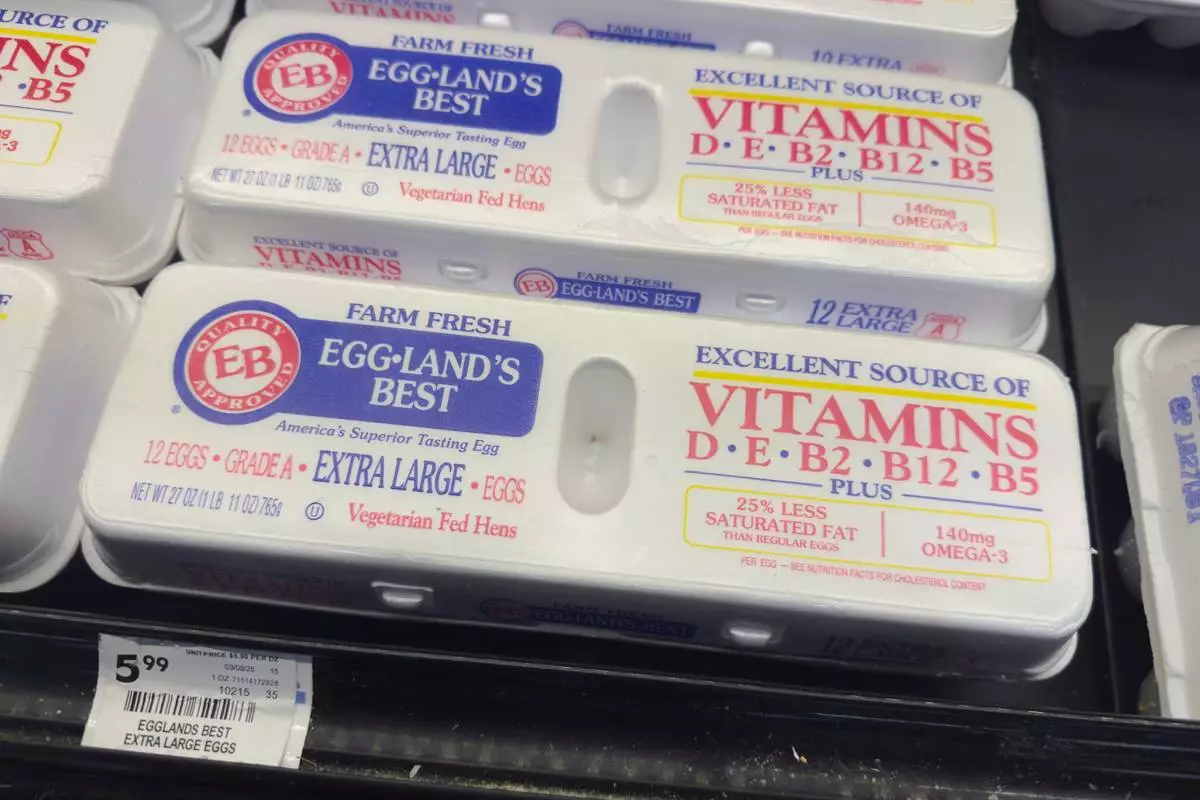
Eggs are displayed in a grocery store in Carmel, Ind., Wednesday, April 9, 2025. (AP Photo/Michael Conroy)

FILE - A carton of eggs sit on a counter in the kitchen inside of 5 Rabanitos restaurant in Chicago, Feb. 16, 2025. (AP Photo/Nam Y. Huh, File)














